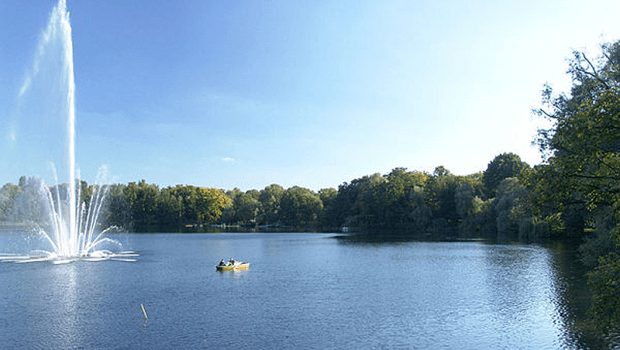
Weißensee: – A city located between two lakes
Weißensee if translated in English is known as the WHITE LAKE CITY. The city is famous for its medieval castle and its annual Bierfest. It has the largest number of castles in Germany. Planned in the Middle Ages, Weißensee is known as one of the oldest planned cities on this planet. It has already been a center of attraction and today is a flourishing tourist hotspot. Its beautiful location and mild weather give tourists the comfort of home. It is best to be explored on foot, admitting each delicate fabrication of architecture. Local transports are easily available, and this city is must visit, as it is the host to world’s largest beer festival. This city of castles is worth visiting. You can also indulge in various delicacies like Thuringian Potato Dumplings and eat breakfast on the bed in a boat, in the middle of the lake.
Location
Weißensee is a country town in the German state Thuringia. Located in the administrative district of Sommerda, it is located around 6km northwest of Sommerda and 25km north of Erfurt. It was always considered an excellent and quite an important strategic location, as it overlooked the copper route that ran from Nuremberg to Magdeburg.
Weather
The climate here is mild and usually warm and temperate. There is a great deal of rainfall in Weißensee even in the driest months. The average annual temperature is 8.7 degree Celsius and receives about 498mm of precipitation annually. The maximum precipitation occurs in June. The hottest month of the year is July whereas the coldest month in Weißensee is January with the average temperature dropping to as low as zero degrees Celsius. The best time to visit Weißensee is in the month of July as the climate is favorable and various festivals also take place during this month.
History
Weißensee was founded in the second half of the 12th century by Jutta Claricia, Landgravine of Thuringia and Sister Emperor Frederick 1. It got its city rights in 1265, and the development began with the building of a massive fortress. The first beginnings of the town grew up together with the castle on the east bank of The White Lake and with the church of St. Nikolas. Besides, due to its excellent geographical strategy, it became an import and trade center for fish and woad, but during Renaissance, it became less important and the two lakes between which it lies, were drained. However, after Congress of Vienna, it got a revival as district capital and the establishment of the Landgrave Castle on the western edge of today’s city made it the major reason for the urban development that followed soon after.
The City
The city consists of approximately 3,720 habitants and is very rich when it comes to art and culture. The art and culture also reflect the architectural style. As Thuringia is the land with most castles across Germany, it is best to be explored on foot. These castles served as a fortress as well as rooms for a living. The architecture and splendid art designs are borrowed from ancient art. One such castle is Runneberg Castle, which is very significant in Weißensee. It consists of Romanesque elements at the fortress gate. In the open space, a tall 18m stone catapult stands. It is a medieval siege machine and operates annually on 21st and 22nd July.
Whereas, the Weißensee Town Hall consists of Romanesque elements and follows Renaissance school of architecture along with other modern techniques of the era. The another tourist attraction – St.Nikolai Church indicated constructional changes in the Gothic period. It consists of elements of the transition period from Romanesque to Gothic. For instance, the octagonal golbet shape is typical from Gothic Era and the main cornice with roundarch is typical from Romanesque Era. Besides, there is a construction of a stone bridge across the river Werra, which is made up of the oldest natural sandstone. The buildings built by Ludwig also display French influences, which is particularly reflected in the rotund design of the towers. In this city, you will also witness unique styles of mural paintings which picture various scenes of the ‘lewin novel’.
Traveling in the City
Public transport facilities are easily available, as buses and taxis and are the best options to take local tours. The famous taxi service is ‘City Taxi’ which goes till Erfurt from Weißensee and vice-versa. You can also take Minivan car rentals near the airport, which provide comfort and space. Car rentals can take up to twelve passengers. The nearest airport to Weißensee is Erfurt airport.
Why Visit?
One of the primary reasons to visit Weißensee is its Bierfest festival, which is a big beer festival. It was discovered in 1998 and is celebrated each year since then. It is known for the purity of the most popular beverage of Germans, and a free beer barrel is available for all. Also, numerous cultural programs are held on stage. Besides, during the festival, a colorful market is set up before The City Hall and in front of the Town Church, which includes keg mountain sprint, Czech specialties, coffee, and cakes. Parallel to this beer festival takes place the great medieval festival at the Runneberg castle. The Walpurga festival at the castle attracts many visitors on the 4th weekend in July. Numerous people flock to Castle to see dragon and magic shows. Besides, you should visit the beautiful city as it consists of various night clubs, liquor stores and hotels which provide bread and breakfast.
Major Attractions
- Runneberg Castle: One of the most remarkable castle complexes in Thuringia.
- Erfurt Cathedral: Hilltop Romanesque and Gothic style Roman Catholic place of worship.
- Weißensee Town Hall: One of the oldest town halls in
- Nikolai Church: It was once the church of the first settlement at the foot of Castle on the banks of Weisse See.
- Museum Of Dairy Farming: A folkloristic exhibition on the history of dairy farming.
- Judischer Friedhof Weißensee: A Jewish cemetery containing 115000 graves and a world War I memorial
- Weißer See: A public swimming pool
- ThüringenZoo Park: It is a large city zoo and conservation center which consists of naturalistic habitats, an aquarium, and animal petting.
- Hainich National Park: The national park is named as a world heritage site and consists of broad forest walks and walking trails.
- Domplatz: Two magnificent churches on a small hill which give the visual delight of the cityscape.
What else is around
- Chinese Garden
- Park En Der Lim
- Rathaus Weimar (town hall)
- Duchess Anna Amalia Library
- Herderkirche Church
- Buchenwald Memorial
- Campingplatz Weißensee
- Barbarossa hotel
- Augustinerkloster
- Ginkgo Museum
- Volkenroda Abbey Monastery
- Merchant’s Bridge
- Wartburg Castle
- Goethe National Museum
